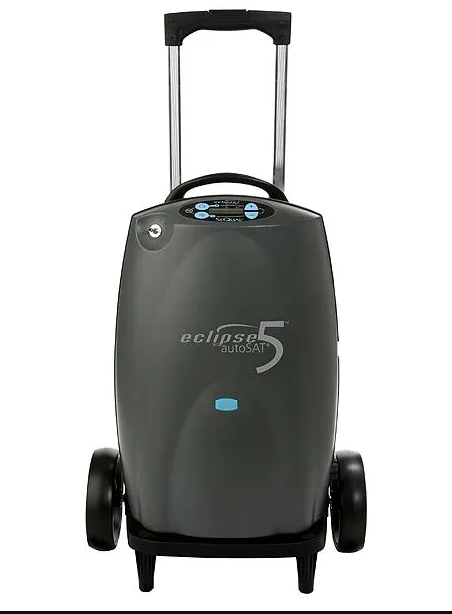The Best Guide To Portable Oxygen Concentrators
Wiki Article
The Best Guide To Portable Oxygen Concentrators
Table of ContentsThe Definitive Guide for Portable Oxygen ConcentratorsWhat Does Portable Oxygen Concentrators Do?Our Portable Oxygen Concentrators StatementsHow Portable Oxygen Concentrators can Save You Time, Stress, and Money.
Stationary oxygen concentrators were when the criterion, yet these containers can weigh 50 extra pounds and were really cumbersome (Portable Oxygen Concentrators). Currently, mobile oxygen concentrators do the job, and they can fit right into a bag or purse! The only thing you ought to maintain in mind is that portable concentrators have more restricted oxygen distribution capacitiesThere are 2 primary kinds of portable oxygen concentrators: pulse dosage and continual circulation. As the name suggests, pulse dose concentrators give oxygen periodically, just triggering when you inhale. This sort of tool is normally suggested for COPD individuals with restricted oxygen requirements, as the quantity of O2 that a pulse dosage concentrator can deliver is relatively reduced.
This gadget can deliver up to 3,000 m, L of oxygen every min, while pulse dose devices often tend to cover out at 1250 m, L. Constant flow tools are the go-to for the majority of COPD individuals, as they're perfect for people that need two to 5 liters of oxygen a min.
Currently that you have this guide to the various kinds of portable oxygen makers, choose the finest device with the assistance of your medical professional.
Everything about Portable Oxygen Concentrators
We are aware Americans use domestic variations in home care situations. We questioned just how well these portable oxygen concentrators would certainly operate in health centers. POC concentrators boost the percentage of oxygen in ambient air individuals inhale, whenever they require a boost. Private-use ones are small sufficient to lug about, and might aid stay clear of the need to go to busy centers and health centers.When it comes to portable oxygen therapy, there are 2 major alternatives for distribution. These are mobile oxygen cyndrical tubes which consist of pressed oxygen gas, or oxygen concentrators, which utilize a battery powered system to compress and filter air, in order to create a regular supply of focused oxygen. In this article, AMS Composite Cylinders Technical Director, Tony Morrin, contrasts the two, checking out the advantages and disadvantages of each oxygen distribution system for NHS medical oxygen customers in regards to client freedom.

Portable Oxygen Concentrator Oxygen pureness is constantly higher when supplied from cylinders it never drops below 99. 6%, no matter of the circulation price required. In battery-powered concentrators, purity is affected by flow price, and might be 90% or much less, relying on the tools. Whilst oxygen concentrators can be useful for clients that visit the site need a reduced circulation of oxygen, cylinders supply greater focus that can be more ideal for people with high flow requirements.
More About Portable Oxygen Concentrators
Both systems require the person to bring about equipment. For cyndrical tubes, this will include bring a bag (and periodically a cart) and for mobile oxygen concentrators this will certainly consist of the bag, trolley and power charger. Weight smart, portable oxygen concentrators can be similar in weight, or sometimes, lighter than typical aluminium cylinder systems.
They will need to boost substantially if they are to provide the exact same degree of efficiency as comparable composite cylinders. Oxygen constantly lugs a safety danger. On one hand, need to cylinders spring a leak, they can produce an oxygen abundant environment that could cause a rise in fire danger.

The difference is that there are significant ahead of time prices to buying a mobile oxygen concentrator, yet reduced running prices using cyndrical tubes allows the purchaser to spread out the expense over an extensive amount of time. One minor drawback of a mobile oxygen blog here concentrator is the noise mobile systems make a substantial amount of sound during operation, which many individuals find disruptive.
See This Report about Portable Oxygen Concentrators

Our top quality carbon composite cylinders supply high stress (300 Bar), low weight, and NLL (Non-Limited Life) efficiency, and are approved for use worldwide. Further details concerning AMS Composite Cylinders Ltd can be found at .
Oxygen concentrators are made with individual movement in mind. Whether it's a desktop variation for home use or a smaller sized, lightweight model for see on-the-go, these tools enable clients to relocate easily without being tethered to a fixed unit. Specifically for the ones particularly developed for transportability, individuals can carry them about, helping with traveling and everyday tasks easily.
One of the significant conveniences of making use of an oxygen concentrator is the elimination of the regular need to replenish oxygen tanks. This not just decreases the logistical obstacles and frequent costs linked with refills but additionally ensures that the customer has a much more foreseeable and stable source of oxygen. Oxygen concentrators are created to fit effortlessly into the home setting.
Report this wiki page